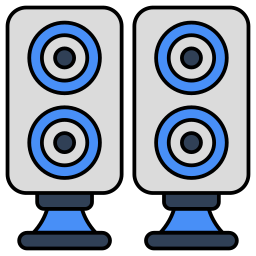
Speakers – External & Peripheral Hardware
Speakers are external peripheral hardware devices that convert digital or analog audio signals into audible sound. They are used to output sound from computers, smartphones, televisions, gaming consoles, and other multimedia devices. As a primary output device for audio, speakers play a critical role in delivering music, voice, sound effects, and other auditory content in both personal and professional environments. Available in various sizes, configurations, and technologies, speakers are integral to modern computing and entertainment systems.
Key Features and Characteristics of Speakers:
Convert electrical signals into sound waves through internal components such as drivers and amplifiers
Connect to source devices via various interfaces, including 3.5mm audio jacks, USB, Bluetooth, RCA, or optical cables
Available in different types such as stereo speakers, surround sound systems, portable Bluetooth speakers, and desktop speakers
Some models include built-in amplifiers, subwoofers, or tweeters to enhance sound quality and frequency response
Offer a range of power outputs and frequency ranges depending on their design and purpose
Desktop and laptop speakers are typically compact and easy to connect for general use
Home theater speakers provide immersive audio for movies and music through multi-channel setups
Many speakers are plug-and-play and do not require complex configuration
Wireless speakers offer mobility and are often battery-powered, making them suitable for travel and outdoor use
Designed to work across multiple platforms and compatible with most operating systems and devices
Common Applications of Speakers:
Listening to music, podcasts, and audiobooks in high-quality audio
Enhancing the audio experience for movies, series, and video content
Providing clear sound in online meetings, webinars, and virtual classrooms
Used in gaming to create an immersive environment through detailed soundscapes
Supporting multimedia presentations in classrooms, offices, and conferences
Employed in public address systems for announcements and communication
Integrated into smart home systems for voice assistants and media playback
Used in events, performances, and public gatherings for sound amplification
Applied in production studios and creative work for audio mixing and sound design
Serving educational environments by providing clear playback of instructional material
Cost and Accessibility:
Speakers are available across a broad price spectrum depending on quality, features, and brand
Basic models for everyday use are affordable and widely accessible
Premium speakers with high-fidelity audio, wireless connectivity, and advanced features cost more
Surround sound and professional-grade studio speakers are more expensive due to their specialized capabilities
Purchasing speakers is a one-time expense with no subscription or recurring fees required for basic use
Some advanced speaker systems may offer optional apps or software for customization, which might be free or paid
Wireless and Bluetooth speakers often include rechargeable batteries, adding to their overall value and portability
Most speakers are easy to set up and don’t require technical expertise, making them suitable for all user levels
Comparison with Other Audio Output Devices:
Compared to headphones and headsets, speakers allow shared listening experiences for multiple users
Headphones may provide more privacy, but speakers deliver fuller sound across a room or space
While built-in laptop or monitor speakers are convenient, external speakers offer superior sound quality and volume
In contrast to portable earbuds, speakers are better for stationary listening or group environments
Bluetooth speakers offer more portability and flexibility than wired speakers but may trade off some audio fidelity
Studio monitors are specialized speakers used in professional settings for accurate audio reproduction, unlike casual consumer speakers
Conclusion:
Speakers are vital hardware components that enable the effective output of audio across countless applications. Whether in a personal, educational, or professional setting, they serve as essential tools for communication, entertainment, and productivity. With a wide variety of models catering to different needs and preferences, users can choose between basic, portable options or advanced systems with high-end sound performance. While other audio output devices may offer more privacy or mobility, speakers remain the go-to solution for high-quality and shared audio experiences. Their ease of use, flexibility, and consistent performance ensure their continued importance in both digital and everyday life.












